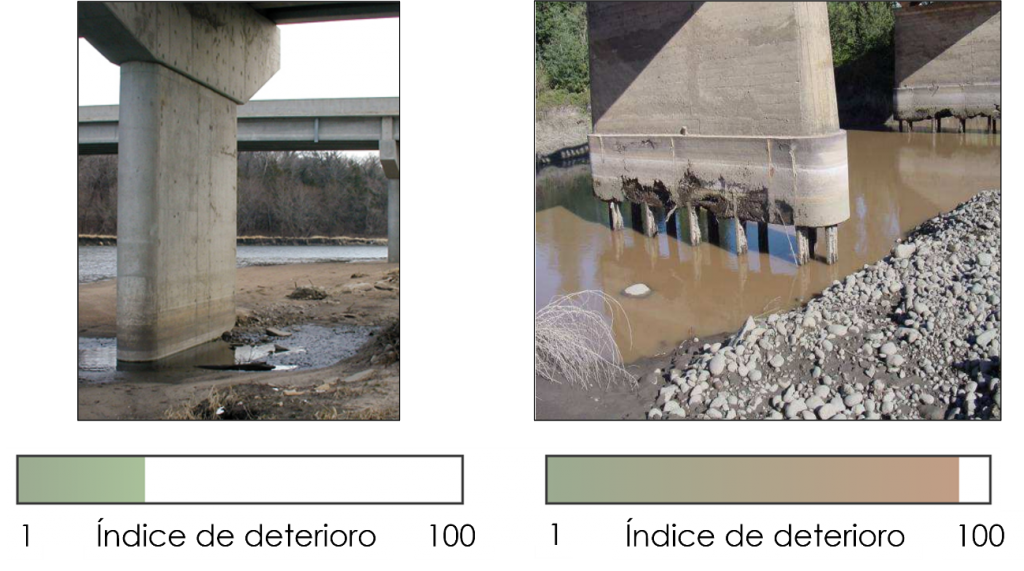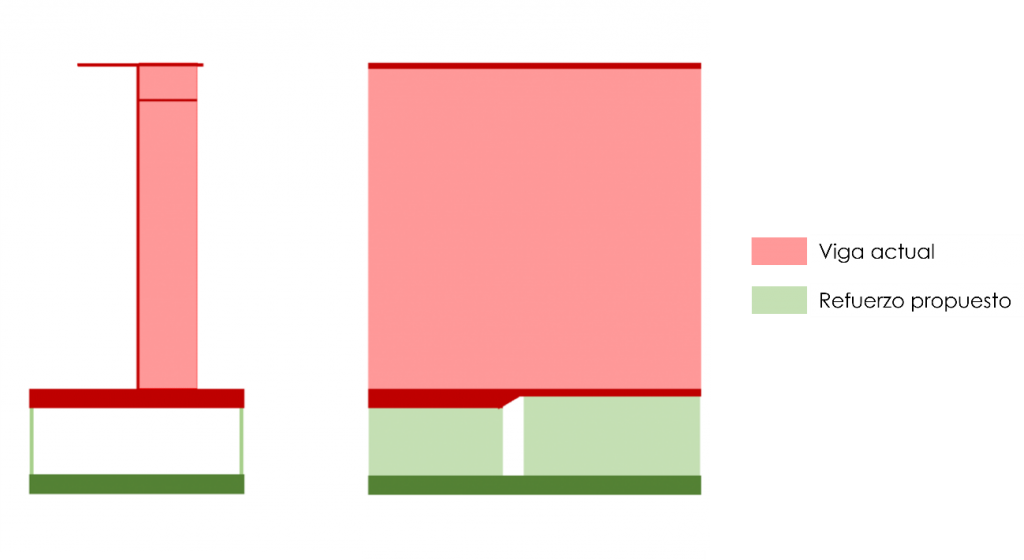Adequate investment in the maintenance of bridges is essential to ensure their safe operation and prolong their service life. Every year, invest requirements are growing due to the increasing ageing of the structures and the fact that they are continuously subjected to external actions which, if not properly addressed and controlled, can risk the stability of bridges and the safety of their users.
In addition to ensuring safety, optimising maintenance investments must be a priority for infrastructure managers, as delaying investments increases costs exponentially. Preventive maintenance interventions have been shown to significantly reduce the total expected cost of this type of activities.
However, managers of a bridge network are often faced with the challenge of making decisions on which structures should receive maintenance measures, especially when resources are limited. In this context, it is particularly important to know how to establish a hierarchy of bridges on a given network, i.e., to know what factors and in which ways it is possible to apply a method that allows the manager to decide on which bridges have the highest priority for maintenance work
Once the prioritisation of bridges has been carried out, it should be noted that a maintenance plan based on the results of traditional visual inspections is not effective if there are defects that have no visible manifestation.
The implementation of advanced Structural Health Monitoring (SHM) systems and the development of a Digital Twin of the bridge is presented as a solution to this problem. By integrating the Digital Twin into the hierarchisation method, managers can make informed, data-driven decisions on which maintenance activities have to be prioritised, on which structural elements of the bridge and when to implement them.
Knowledge of how to manage resources through hierarchisation methods
All bridges need maintenance and structural monitoring is a tool to optimise and prioritise maintenance actions. Therefore, having a high percentage of bridges monitored is the ideal solution.
However, this objective is often not achievable in the short term for economic reasons and the manager of a bridge network must determine which are the highest priority bridges, i.e., those on which maintenance activities should be carried out first.
IDVIA not only provides innovative SHM technology for structural health monitoring of bridges, but has also developed a bridge ranking method based on the application of mathematical modelling and multicriteria analysis. This method provides as a result a classification of those bridges that need to be treated in advance.

Classification of bridges requiring pre-treatment as a result of the hierarchisation method.
Mathematical models of multicriteria analysis make it possible to combine different criteria and assign relative weights to them according to their importance and their current deterioration rates. The objective is to analyse all the available data and background information on the bridges in the network under study, based on different parameters with which we can classify as objectively and comprehensively as possible those bridges in the network that should be monitored first.

Bridge with low scour deterioration index (left) (Fondriest Environmental, Inc., 2014); Bridge with high scour deterioration index (right) (Márquez, M., Valenzuela, M., Milla, P. & Vidal, P., 2017).
There are a multitude of parameters to be taken into account for the implementation of this type of analysis. Some of the most important criteria that have the greatest impact on bridge maintenance are as listed below.
Strategic parameters
- Traffic intensity. Priority for SHM application should be given to high-demand bridges on the network.
- Alternative routes. The longer the time needed to take an alternative route, the greater the importance of applying SHM techniques.
Structural parameters
- Older structures are more attractive than newer ones for the application of advanced SHM systems.
- Structural health. Through a visual inspection, it is possible to determine the preliminary state of health of the structure. It should be noted that pathologies that are difficult to identify in a visual inspection, such as carbonation, cannot be taken into account in this criterion.
- Bridge length. The larger the size of the bridge, the greater the maintenance investment required to ensure the safety of its users. Therefore, to avoid exponential cost increases, longer bridges are prioritised.
Environmental parameters
- The riverbed behind bridges with intermediate supports must be taken into account. The type of riverbed or nearby vegetation defines this criterion.
- This dangerous phenomenon can lead to the collapse of the structure in certain situations, and is therefore an essential criterion to be taken into account for determining which bridges to monitor first.
- Seismic activity is sometimes essential, as these phenomena can affect the stability and integrity of structures.
Some of the evaluation parameters are adaptable to the infrastructure manager’s preferences, but others must always be incorporated. With this information, our hierarchisation algorithm enables data-driven and objective decision-making, allowing optimisation of the schedule of actions on any bridge network.
Digital Twin, the ideal complement to a hierarchisation method
Once the hierarchy has been established as to which bridges should be monitored first within a network, the following questions need to be asked:
- What maintenance actions does the bridge need?
- How often does it need them?
One of the most powerful tools to support the hierarchisation process and answer these questions is a Digital Twin. A Digital Twin is a finite element numerical model that is a virtual replication of the physical structure it represents. It provides a detailed and accurate digital representation of the bridge, allowing continuous monitoring of its condition and behaviour.
IDVIA’s innovative SHM system enables Digital Twin to be integrated into multicriteria analysis, being able to identify problem areas and assess the risk of failure, allowing informed decisions to be made to allocate resources optimally.
From a strategic installation of sensors to collect the necessary information to know the dynamic behaviour of the bridge to the consolidation of a calibrated numerical model is what IDVIA offers, in addition to the incorporation of other IDVIA’s own methodologies throughout the different stages of the process.
Digital Twin facilitates early problem detection and trend analysis over time. This provides valuable information to assess performance, structural health of the infrastructure and future interventions.
In addition to being able to check the current state of health of the structure, taking into account pathologies that cannot be identified in a visual inspection, it is possible to carry out numerical simulations in which modifications are applied to the structure. In the event of anomalous behaviour of any of its structural elements, a Digital Twin can simulate the response of a bridge to a possible modification, such as the incorporation of a reinforcement, whose work has been carried out by IDVIA on the Calle Calle bridge in Chile.

Design of the proposed reinforcement for the Calle Calle bridge after structural health diagnosis using SHM techniques and the development of a Digital Twin.
The development of a Digital Twin is the ideal complement and the immediate next step after the application of the hierarchical approach, i. e. knowing which bridge to work on first, advanced SHM techniques are applied for optimal maintenance
Our opinion as experts
The hierarchisation or prioritisation of maintenance activities on bridge is essential to ensure their safe and efficient operation. Advanced SHM systems can provide more frequent or continuous information on structures, but in a resource-constrained situation they cannot be installed on all bridges in a network.
IDVIA has developed a multicriteria analysis tool using mathematical models to select which bridges to install SHM on according to different parameters that affect costs (strategic, structural and environmental). As a result, this method provides a classification or hierarchy of bridges on which maintenance tasks should be prioritised.
The use of the Digital Twin in hierarchisation and prioritisation enables more efficient management of maintenance resources by identifying and addressing issues proactively. Continuous monitoring of bridge condition through a Digital Twin supports the identification of maintenance needs in a timely manner, allowing issues to be dealt with before they become costly or dangerous failures.
IDVIA proposes an approach that combines multicriteria analysis with SHM technologies and the development of Digital Twin, improving the safety of the bridge network, extending its service life and maximising the use of available resources. This is fundamental element in ensuring effective and sustainable management of the network.
The implementation of advanced SHM systems and the development of a Digital Twin of bridges resulting from the hierarchisation is presented as a key tool to know the needs of each structure, minimising the investment in maintenance by acting at the optimal moment through the necessary maintenance or reinforcement operation.
References
Andrés, L., Ribes, F., Fernández, E. & Maldonado, J. (2022). Application of mathematical models and multicriteria analysis to establish an optimized priorization for the maintenance of bridges in a network. Modelling for Engineering & Human Behaviour 2022.
Fondriest Environmental, Inc. (2014). Monitoring Scour at Bridges and Offshore Structures. Fundamentals of Environmental Measurements. Disponible en: https://www.fondriest.com/environmental-measurements/environmental-monitoring-applications/monitoring-scour-bridges-offshore-structures/
Gómez, D., Marulanda, J. & Thomson, P. (2008). Sistemas de control para la protección de estructuras civiles sometidas a cargas dinámicas. Dyna, 75 (155), 77–89.
Kong, Jung S., & Frangopol, Dan M. (2003). Evaluation of expected life-cycle maintenance cost of deteriorating structures. Journal of Structural Engineering, 129 (5), 682-691.
Márquez, M., Valenzuela, M., Milla, P. & Vidal, P. (2017). Procedimiento de refuerzo de puentes tradicionales chilenos: socavación y sismo. Revista Portuguesa de Engenharia de Estruturas, 4, 91-104.

